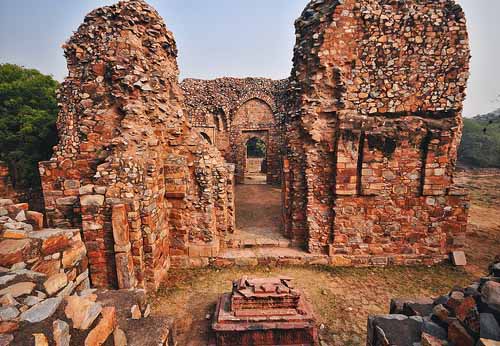Balban's Tomb

Information on Balban's Tomb (New Delhi) - History & Architecture
Balban's Tomb is situated in Mehrauli Archaeological Park of New Delhi. It was established in the year 1287 and thus possess significant historical significance. Balban's Tomb was the first true arch made establishment of India. It is a 13th century grave where the last sultan of Slave family, i.e. Balban was buried and therefore regarded as Sultan's ultimate resting place.
Balban's Tomb Architecture
Balban's Tomb is an impressive stonework building. However, it lacks grand decoration, which can be observed in the tomb of his master namely IItumish. Balban's Tomb is surrounded by the wrecks of a widespread primitive settlement and delivers a remarkable view of Qutub Minar. In the east side of Balban's Tomb, there lies a derelict four-sided construction which is believed to be the grave of king Shahid, son of Balban. The entrance of the tomb is characterised by black trilateral rooftop. The gate demonstrate certain additions, particularly carved decorative pillars that gilded huge walls.
Balban's Tomb History
Balban who was originally Baha-ud-din was considered as one of the most efficacious Sultans, who ruled over India. He was quite powerful, diligent, visionary and energetic in nature. Originally he was a slave and was sold in Afghanistan. His master was a devout man and has provided education to Baha-ud-din along with his own children. Baha-ud-din was also given military teaching which was regarded as an asset by slave traders on that time, as educated slave can bought high amount of money in comparison with uneducated ones. Later sultan of Delhi, IItumish bought Baha-ud-din and entrusted him to his slave groups. On that time, becoming a king's slave was regarded as a tribute. As a consequence of king's slave, Baha-ud-din obtained great power comprising warfare information and even freed from his slavery and make his position as a military general. With his hard works, Baha-ud-din progressed from one position to other and gathered great authority in his hand after the demise of IItumish. He supported the successors of IItumush in various military movements and engaged his own relatives as rulers of vital provinces. He assisted Nasir-ud-Din for commandeering the authority of Delhi and afterwards he wedded his daughter and certified that the authority befall in his hand after the death of Nasir-ud-Din. Baha-ud-din methodically abolished every opposition parties who stood before his sovereignty.
After the death of Nasir-ud-Din, Baha-ud-din soared the authority of Delhi with the title Balban. He ruled with strong power and was famous for his rapid reaction, callousness and the activity of never forgetting and pardoning. He built several forts and frontiers for protecting his kingdom from Mongol incursions. He had also constructed barracks as defensive measures and ruling mechanisms. During his sovereignty, Balban ordered the resources of his interests for creating his tomb. At present, his huge tomb and neighbouring cityscape lie in the wrecks of Mehrauli Archaeological Park of Delhi.
Balban's Tomb Tourism Significance
Balban's Tomb is regarded as one of the most vital architectural milestones of Indian history. It comprises the architectural bequest of many periods. Balban's Tomb demonstrate fine structures and skills of artists and designers from oversees nations. It is regarded as an honour of his success and societal position. Thus, it can provide great pleasure to the travellers to explore. The historic significance of Balban can appeal travellers towards the tomb and makes it a great place to visit.
- Andaman Nicobar Monuments
- Andhra Pradesh Monuments
- Assam Monuments
- Bihar Monuments
- Chhattisgarh Monuments
- New Delhi Monuments
- Goa Monuments
- Gujarat Monuments
- Haryana Monuments
- Himachal Pradesh Monuments
- Jammu and Kashmir Monuments
- Karnataka Monuments
- Kerala Monuments
- Madhya Pradesh Monuments
- Maharashtra Monuments
- Odisha Monuments
- Punjab Monuments
- Rajasthan Monuments
- Tamil Nadu Monuments
- Telangana Monuments
- Uttar Pradesh Monuments
- West Bengal Monuments